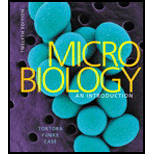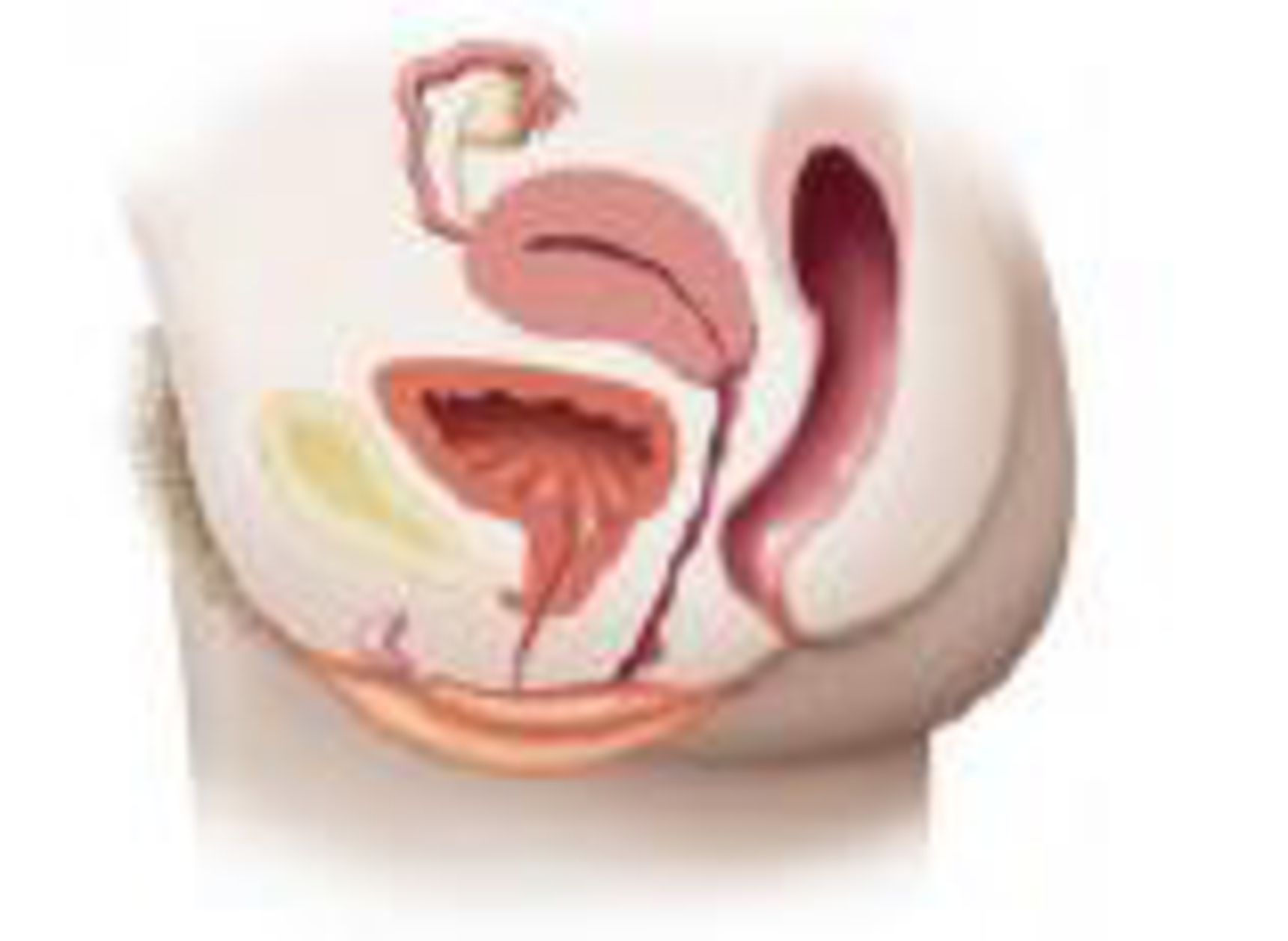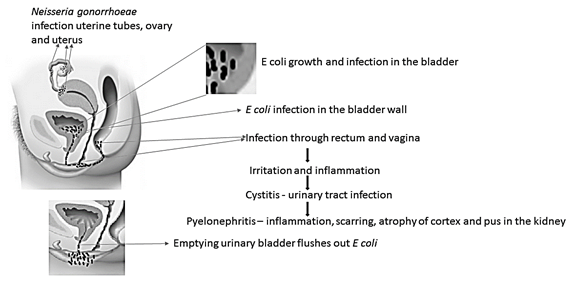
coli to cause cystitis. Do the same for pyelonephritis. Diagram the pathway taken by Neisseria gonorrhoeae to cause PID.

To draw:
Pathway taken by E. coli to cause cystitis and pyelonephritis. Pathway taken by Neisseria gonorrhoeae to cause PID
Pictorial representation:

Concept introduction:
Cystitis is a urinary tract infection, mostly caused by E coli. Bacterial growth in the urothelium of the bladder through rectum, urethra, perineum and vagina causes cystitis. Pyelonephritis is an inflammatory disease of kidneys, mostly caused by E coli. Bacteria can reach kidney through lower urinary tract and bloodstream. Pelvic inflammatory disease or PID is a severe bacterial infection of pelvic organs of women, mostly caused by N gonorrhoeae.
Explanation of Solution
Cystitis is a common urinary tract infection, caused by Escherichia coli (E coli) bacteria. Nearly 70-95% of the urinary tract infections are caused by E coli. It is a gram-negative, anaerobic, rod-shaped bacteria. It is commonly found in environment, skin and intestines of animal and human. Mostly they are harmless and help in digestion, and sometimes they can cause serious health problems like diarrhea, cystitis (urinary tract infections), respiratory problem, pneumonia, food poison and others. Cystitis is primarily caused by Escherichia coli and also by Staphylococcus saprophyticus, Klebsiella species, Proteus species and Enterobacter species. E coli covers the lining of the bladder and causes irritation and inflammation which leads to cystitis. Cystitis affects people in all age groups, however, it is more common in women than men due to the short urethra, which is less than 2 inches. The female urethra is very close to anal opening, hence it may lead to intestinal bacterial contamination. It can be prevented by drinking plenty of water which can flush bacteria and also with personal hygiene. Cystitis can be treated with antibiotics such as nitrofurantoin, trimethoprim - sulfamethoxazole, fluoroquinolone and ampicillin.
Pyelonephritis is an inflammatory disease of kidneys, caused by bacterial infection. It is a life-threatening disease which severely damages one or both kidneys and causes renal scarring. More than 70% of pyelonephritis is caused by E coli and rarely by Enterococcus faecalis, Pseudomonas aeruginosa and Klebsiella species. Bacteria can reach kidney through lower urinary tract and bloodstream. Initially, it infects bladder and move to kidney and severely damage one or both kidneys. Lower urinary tract infection is very vulnerable for kidney damage and pyelonephritis. Pyelonephritis is more common in women than men due to short urethra, which is less than 2 inches. The female urethra is very close to anal opening, hence it may lead to intestinal bacterial contaminations. Second or third generation cephalosporin is used to treat pyelonephritis.
Pelvic inflammatory disease or PID is a severe bacterial infection of pelvic organs such as uterus, cervix, uterine tubes or ovaries in female. N gonorrhoeae and C trachomatis are common microorganisms mostly responsible for PID. Uterine tubes infection or salpingitis by N gonorrhoeae leads to scarring which blocks ovary. The uterine block may cause ectopic pregnancy. Salpingitis causes10-15% infertility in women. PID can be treated with doxycycline and cefoxitin.
Cystitis is a urinary tract infection, majorly caused by E. coli leads to irritation and inflammation of the urinary bladder. Pyelonephritis is an inflammatory disease of the kidney caused by E coli. PID is an inflammatory diseases of female pelvic organ caused by N gonorrhoeae.
Want to see more full solutions like this?
Chapter 26 Solutions
Microbiology: An Introduction
Additional Science Textbook Solutions
Campbell Essential Biology with Physiology (6th Edition)
Campbell Biology (10th Edition)
MARINE BIOLOGY
Human Anatomy & Physiology (11th Edition)
Biological Science
Genetic Analysis: An Integrated Approach (3rd Edition)
- Name the causes that results in ketacidosisarrow_forwardtalk about GERD (gastroesophageal reflux disease) in detail, by saying what it is, how it affects the digestive system, symptoms of it, and how to treat.arrow_forwardneisseria gonorrhoeae attached to the mucosal epithelium and causes infection by phagocytosis lysis endocytosis apoptosisarrow_forward
- Coliform bacteria are common contaminants of meats. High coliform counts in food indicate the potential for finding which intestinal pathogens?arrow_forwardWho is more likely to get gallstones/cholelithiasis people that live in a hot climate or cold climate setting?arrow_forwardExplain how primary gout can result from the following enzymes in the image below.arrow_forward
- talk about GERD (gastroesophageal reflux disease) in detail, by sayinghow it affects the digestive system, symptoms of it, and how to treat it.arrow_forwardExplain why the liver is a common site of secondarycancer.arrow_forwardHaving an E. histolytica infection. Fecal examination reveals the presence of blood in the stool, suggesting damage to the intestinal mucosa. Explain why and how the mucosa was compromised by this parasite.arrow_forward
- Antimicrobial therapy can decrease the amount of susceptible bowel flora and allow proliferation of relatively resistant colonic bacteria. Which one of the following species can proliferate and produce a toxin that causes diarrhea?- a.Enterococcus species b.Staphylococcus epidermidisC.Pseudomonas aeruginosad.Clostridium difficilee.Bacteroides fragilisarrow_forwardIn patient with Maple Syrup Urine Disease, what specific amino acids should be not used in order to ameliorate the existing diseases condition? Why have you selected these amino acids?arrow_forwardThe Helicobacter pylori protobacteria cause peptic ulceration by producing: asaparrow_forward
- Understanding Health Insurance: A Guide to Billin...Health & NutritionISBN:9781337679480Author:GREENPublisher:Cengage
